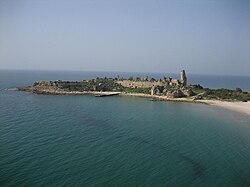Atlit (modern town)
Atlit
| |
|---|---|
| Hebrew transcription(s) | |
| • unofficial | Atlith |
 Atlit fortress | |
| Grid position | formerly 144/234, now 144/232 PAL |
| Country | Israel |
| District | Haifa |
| Founded | 1903 |
| Population (2022)[1] | 10,929 |
Atlit (Template:Lang-he-n) is a coastal town located south of Haifa, Israel. Originally an outpost of the Crusaders, it fell in 1291. The Jewish village was founded in 1903 under the auspices of Baron Edmond de Rothschild. In 2022 the population was 10,929. The Atlit detainee camp is nearby.
History
Template:Infobox former Arab villages in Palestine
Atlit Yam is an ancient submerged Neolithic village off the coast of Atlit, Israel. Atlit-Yam provides the earliest known evidence for an agro-pastoral-marine subsistence system on the Levantine coast.[2]
Atlit shows evidence of human habitation since the early Bronze Age. The Crusaders built Chateau Pelerin, one of the largest citadels in the Holy Land, and one of the last remaining Crusader outposts to withstand the assaults of Baibars (see also: Fall of Ruad).[citation needed] Atlit remained in Crusader hands until 1291. The ruins of the citadel are still visible in modern times. In 1296, during Mamluk rule, Atlit and its surrounding area was settled by members of the Tatar 'Uwayrat tribe. In 1596, during Ottoman rule which began in 1517, Atlit was recorded as a farm that paid taxes to the government.[3]
During the rule of Acre governor Sulayman Pasha al-Adil, Atlit was the headquarters of local strongman Mas'ud al-Madi, who was appointed the mutasallim (tax collector/enforcer) of the Atlit coast, which consisted of the territory that stretched from Umm Khalid to Haifa.[4][5] In 1859, the population was stated to be "180 souls", and their tillage 13 feddans, according to the English consul Rogers.[6] In 1881, the Survey of Western Palestine noted the existence of a small Arab village.[6] In 1903, Jewish settlers build a nearby village which they also called Atlit.
During the British Mandate of Palestine, the Arab and Jewish villages were treated statistically as part of the same community. In 1938 there were 508 Arabs and 224 Jews. The Arab presence underwent a sharp decline in the 1940s due to land sales, so that by 1944/5 there were only 150 Arabs still living there (90 Muslims and 60 Christians) alongside about 2,000 Jews. The circumstances under which the remaining Arabs left in 1948 are unknown.[7][8] Atlit detainee camp was used by the British authorities to detain Jewish immigrants to Palestine.[9] It is now a museum of the Ha'apala. A base of Israel's naval commando is located nearby.
Atlit was declared a local council in 1950, but in 2004 was incorporated in the Hof HaCarmel Regional Council as one of a handful of Regional Committees. The late Knesset member Pesah Grupper lived in Atlit. He was head of its local council in the years 1959-1962 and 1969-1971.
Neighborhoods
Neighborhoods in Atlit are Neve Moshe, Yamit, Giv'at HaPrahim, Giv'at HaBrekhot, Giv'at Sharon, Shoshanat HaYam, HaGoren, Yafe Nof, Argaman, Hofit, Savyonei Atlit and Allon. Atlit is in immediate vicinity of the villages Neve Yam and Ein Carmel.
Twin towns
See also
References
- ^ "Regional Statistics". Israel Central Bureau of Statistics. Retrieved 21 March 2024.
- ^ Marine archaeology
- ^ Khalidi, 1992, p. 147.
- ^ Philipp, Thomas (2013). Acre: The Rise and Fall of a Palestinian City, 1730-1831. Columbia University Press. p. 88.
- ^ Yazbak, Mahmoud (1998). Haifa in the Late Ottoman Period, A Muslim Town in Transition, 1864–1914. Brill Academic Pub. p. 17.
- ^ a b Conder and Kitchener, 1881, SWP I, p. 274
- ^ Khalidi, 1992, pp. 146-147
- ^ Cite error: The named reference
Morris387was invoked but never defined (see the help page). - ^ http://www.hadassah.com/news/content/per_hadassah/archive/2003/03_FEB/traveler.htm
Bibliography
- Barron, J. B., ed. (1923). Palestine: Report and General Abstracts of the Census of 1922. Government of Palestine.
- Conder, Claude Reignier; Kitchener, Herbert H. (1881). The Survey of Western Palestine: Memoirs of the Topography, Orography, Hydrography, and Archaeology. Vol. 1. London: Committee of the Palestine Exploration Fund. p. 281
- Hadawi, Sami (1970). Village Statistics of 1945: A Classification of Land and Area ownership in Palestine. Palestine Liberation Organization Research Center.
- Irby, Charles Leonard; Mangles, James (1823). Travels in Egypt and Nubia, Syria, and Asia Minor; during the years 1817 & 1818. London: Printed for Private Distribution by T. White & Co. Irby and Mangles, 1823, p. 191
- Khalidi, Walid (1992). All That Remains: The Palestinian Villages Occupied and Depopulated by Israel in 1948. Washington D.C.: Institute for Palestine Studies. ISBN 0-88728-224-5.
- Mills, E., ed. (1932). Census of Palestine 1931. Population of Villages, Towns and Administrative Areas (PDF). Jerusalem: Government of Palestine.
- Morris, Benny (2004). The Birth of the Palestinian Refugee Problem Revisited. Cambridge University Press. ISBN 978-0-521-00967-6.
- Palmer, E. H. (1881). The Survey of Western Palestine: Arabic and English Name Lists Collected During the Survey by Lieutenants Conder and Kitchener, R. E. Transliterated and Explained by E.H. Palmer. Committee of the Palestine Exploration Fund.
External links
- Welcome To 'Atlit
- Survey of Western Palestine, Map 5: IAA, Wikimedia commons

